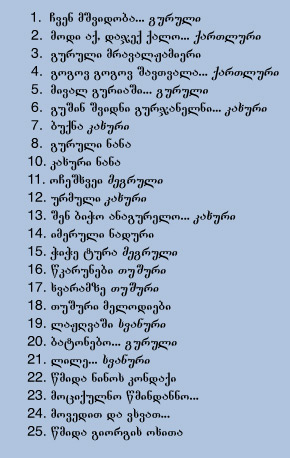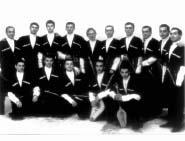|
- Catalog (in stock)
- Back-Catalog
- Mail Order
- Online Order
- Sounds
- Instruments
- Projects
- History Face
- ten years 87-97
- Review Face
- our friends
- Albis Face
- Albis - Photos
- Albis Work
- Links
- Home
- Contact
- Profil YouTube
- Overton Network
P & C December 1998
- Face Music / Albi
- last update 03-2016
|
1. Chven mshvidoba..., table song, Guria - 2:24
2. Modi ak, dajek kalo..., Kartli - 3:45
3. Mravalzhamieri, table song, Guria - 1:35
4. Gogov gogov shavtvala..., Kartli - 1:54
5. Mival guriashi ..., Guria - 2:24
6. Gushin shvidni gurjanelni..., K'akheti - 4:27
7. Bukna, dance tune for panduri, K'akheti - 2:04
8. Nana, cradle song, Guria - 2:36
9. Nana, cradle song, Samegrelo - 2:32
10. Nana, cradle song, K'akheti - 2:53
11. Ochechkhvei..., harvest song, Samegrelo - 3:13
12. Urmuli, waggoners' song, Kartli, K'akheti - 4:01
13. Shen bich'o anagurelo..., K'akheti - 4:35
14. Naduri, work song, Imereti - 3:10
15. Ch'ich'et'ura, the little jackal, Samegrelo - 3:04
16. Ts'k'arunebi, dance tune for panduri, Tusheti - 2:03
17. Khvaramze, love song, Tusheti - 2:12
18. Melodies from Tusheti - 4:41
19. Lazhghvashi, ritual song, Svaneti - 2:51
20. Bat'onebo..., ritual song, Guria - 3:18
21. Lile..., ritual song, Svaneti - 3:04
22. Kondak of Saint Nino - 3:00
23. Tropar of the holy apostles - 2:08
24. Movedit da vsvat..., Easter Hirmos - 1:40
25. Tropar of Saint George - 4:27
|
 |
Traditional Georgian music was not originally intended for presentation in a concert hall. These centuries-old, orally handed-down songs evolved out of life's important moments within society. Although concert presentation of Georgian songs now has a tradition going back one hundred years, the archaic connection can still be clearly felt, as indeed, many of these songs continue to have their place in daily life today. Backed by old archive recordings and the still-living tradition in the villages, Ensemble GEORGIKA, founded in 1989, wishes to promote the continuation of both concert presentation and the age-old tradition of singing these songs.
The texts and the musical structure of traditional Georgian songs illuminate the specific thoughts and way-of-life of a people with more than two thousand years of history and culture. For example, traditional instrumentation consisting of a collectively sung bass line supporting one or two higher solo lines, reflects a characteristic social model, existing between the individual and the group, where everyone is able to participate and no one remains an unengaged listener.
The songs had many functions in a traditional village community:
- Table songs did not only express joy at the festivities. The textual forms of blessing elevated the meal shared with a guest to the level of ritual, which both strengthened the individual participant and the community, and further affirmed the existing social norms.
- The songs of the two groups competing against one another during field work (Naduri), serve on the one hand, to organize the work and increase group productivity, and on the other, to transform the physically extremely strenuous days into a festival, where old fertility rites could continue to be celebrated.
- The perkhuli, or circle dance, also performed by two alternating groups, joins dance to words and music. Most of these songs are associated with festivals and customs of a religious nature. One finds them especially often in the high mountain regions, where religious concepts often have no more in common with the Georgian-Orthodox Church than the name.
These peasant songs, sung in region-specific ways, (see map sketch), constitute only half of the traditional folk music of Georgia. The embodiment of this advanced Christian civilization was not only to be seen in the leading architecture of its many churches, its frescoes, icons, book paintings or its religious and secular literature. The spiritual centers of Middle Ages Georgia were also centers of religious vocal art. Here, peculiar within the Orthodoxy, a three-part form of liturgical singing developed, which for the most part, was also handed-down orally. Only in the 19th century, when Georgian churches lost their autonomy (Autokephalie) as a consequence of the Russian occupation of 1801, and the services became increasingly Russianized, did the priests and musicians begin to set down the orally-transmitted songs in written form. These constitute an important foundation for the re-birth of this vocal art, almost totally obliterated during the time of the Soviets (1921-1990).
- map sketch Georgia
Table Songs
In Georgia a guest is considered a Godsend, in spite of the many unwanted guests, which the country in its long history has had to endure. The table prepared in honour of the guest is the focal point of social life, improvised speeches and music. The toasts of the table master (tamada) constitute some of Georgia's most elaborate and artistic songs.
- 1. Chven mshvidoba... "Peace to us", table song from Guria.
(Davit Shanidze, Archil and Malkhaz Ushveridze, soloists)
|
"Peace to us, good day. / Our happy host / has beloved guests. / God, let never separate from him, / all whom he loves."
In the southwestern region of Guria, total independence has been attained by the simultaneously sounding solo voices. In order to facilitate the free arrangement of these vocal lines, the singers string together nonsense syllables over long passages; the text by contrast, is condensed into a few bars.
|
- 2. Modi ak dajek kalo... "Come girl, sit down here..." from Kartli.
Solo: Mamuk'a Ch'ich'inadze. In this dance-like tune an old man gives advice to a young, unmarried girl.
|
- 3. Mravalzhamieri from Guria.
The blessing mravalzhamieri (long years), has found its own musical form in almost every region (see Vol.I, No. 6, Vol.III, No. 5). This Gurian version is closely related to the West Georgian ecclesiastical hymn; hardly a coincidence, as the priest dismisses the congregation after Mass with precisely these words.
|
- 4. Gogov gogov shavtvala... "Black-eyed girl...", love song from Kartli.
Solo: Mamuk'a Ch'ich'inadze
|
"Girl, girl, you black-eyed one, / A boy sends you greetings: / Either give me back my knife, / Or you are mine. / Girl, girl, you black-eyed one."
Refrain after every line: "Livliv, girl, beloved one, / Liakhvo, my beloved, liakhvo."
|
- 5. Mival guriashi... "I go to Guria..." - love song from Guria.
(Davit Shanidze, Manuchar K'asradze, Malkhaz Ushveridze, soloists; Manuchar K'asradze, Chonguri, 4-stringed West Georgian lute)
|
"I am going to Guria, but / my soul has passed me by. / I chased after it, it did not look back, / would not even accept a tribe.
My only truly beloved / in the whole world, / soon I will be with you, / never will I leave you, never, never."
|
- 6. Gushin shvidni gurjanelni... "Seven from Gurjaani..." table song from K'akheti.
Solo: Mamuk'a Ch'ich'inadze.
|
"Seven from Gurdschaani (a place in K'akheti) / went hunting yesterday. / They shot a white wild boar, / then went to hunt other game. / All seven shot seven times, / without anyone hitting anything. / Then the old grandfather shot: / On his horns hangs the ibex."
|
- 7. Bukna. Music for a "Dance with Bent Knees", performed on a diatonic lute from K'akheti, the three-stringed counterpart to the West Georgian chonguri.
|
Cradle songs
Women and men in Georgia rarely sing together. The women have their own songs, many of which are connected with rituals to heal sick children, to lament the dead; and circle dances for holidays. Their many-voiced cradle songs have become especially popular.
- 8. Nana from Guria.
Solo: Davit Shanidze, Chonguri: Manuchar K'asradze.
|
"This cradle is of mulberry wood: / in it a boy seemingly of crystal.
|
- 9. Nana from Samegrelo.
Manuchar K'asradze, Chonguri
|
- 10. Nana from K'akheti.
Solo: Mamuk'a Ch'ich'inadze.
|
The introductory solo quotes lavnana, a ritualist song for healing sick children (see No. 20, a Gurian version).
|
Work Songs
In West Georgia nadi, a custom requiring unpaid help from one's neighbours, transforms the most strenuous time of the year into festival, which singing and working form an inseparable unity. Some of these long naduri, sung antiphon ally by two groups, have texts which are reduced to only a few words (11), or dispensed with altogether (14).
- 11. Otchetchkhvei... Harvest song from Samegrelo.
Solo: Shalva Lortkipanidze
|
- 12. Urmuli, waggoners' song from Kartli and K'akheti.
Solo: Zaza Sidamonidze. |
Peasants from many villages, travelling with their heavy carts, undertake the long trip to the source of the Mt'k'vari, in present-day Turkey, where they mine for salt.
|
"Pull, my oxen, pull; / it will soon be daylight. / The sun will overtake us, it will become hot, / and the trip will become more difficult.
I am going to Aghzewan for salt, / to bring back crystal-clear salt: / once home I will embrace my mother, / then the children and my wife.
|
You, my buffalo, my good / nik'ora, mother of buffalo calves, / your calves, which you raise, / will go with me for salt."
|
- 13. Shen bich'o anagurelo... "You lad from Anaguri..." Song for field work from K'akheti.
(Davit Shanidze and Mamuk'a Ch'ich'inadze, soloists)
|
"Arulalo, lad from Anaguri, / your voice rings out, your sweet voice. / The sound of your hoe / resounds away over the river."
|
- 14. Naduri from Imereti. Without text.
Shalva Lortkipanidze, Mamuk'a Ch'ich'inadze, Sandro Mirianashvili, soloists)
|
- 15. Ch'ich'e t'ura. "The little jackal".
|
A jesting song with many characters: Tura, a little jackal has broken into the chicken coop. The peasant scolds his wife for having left the coop open. Tura pleads for leniency: "You certainly don't have too few chicken. I am only taking one or two."
|
Tusheti
In the mountains of Eastern Georgia, the text has priority over the music. Impromptu poetry is as widespread as musical improvisation in the valley. The songs from Tusheti, a region practically deserted today except in summer, are often for one voice. In addition to the expressive power of the texts, the melodic suppleness of the songs has made them popular in all of Georgia. They have frequently been arranged for other voice or instrumental combinations.
|
- 16. Ts'k'arunebi, "Ringing".
Goderdzi Khvtisiashvili on a diatonic Panduri.
|
The title of this virtuostic dance piece, "Ringing", refers to a special playing technique: the rapid embellishments, not all possible to execute with the right hand alone, need the assistance of the free fingers of the left hand by the finger board.
|
- 17. Khvaramze. Love song from the women's repertoire.
Mamuk'a Ch'ich'inadze, solo, Zaza Sidamonidze, Panduri.
|
"Who are you, striding along / on this cold, high mountain. / The Leaks shall not shoot at you, / lightening will not strike me!
If I could become a silver cup, / so that I could fill myself with wine for you: / if I were of a red colour, / and you would drink me, and I would agree with you. / If I were a silver thimble, / so that I could slip myself on your finger; / or a golden ball (of wool), / so that I could unravel myself on your lap: / or for your sickle a field, / mowed down by your blade; / or a rosebud, / that I could shed my petals on your lips; / or a cambric shirt, / that I could melt on your heart; / or your chosen one, / that I could, as pain, cut into your heart / and then meet you, full of sorrow / on the way.
|
- 18. Melodies from Tusheti.
(Alek'o Khizanishvili, Salamuri; Goderdzi Khvtisiashvili, Panduri; Davit Bukhsianidze, Bass panduri)
|
Instrumental version of the preceding song, followed by a dance tune. The Salamuri, a kind of recorder used by the shepherds of Tusheti, is accompanied here by 3-stringed, chromatically-tuned lutes; an arrangement created recently for the concert stage.
|
Ritual Songs
- 19. Lazhghvashi.
This song for 2 choirs, to a text which is purportedly not even understood anymore by the Svans themselves, is accompanied by a ch'uniri, a hide-covered knee-violin, whose three horse-hair strings are bowed simultaneously. Svaneti is a high mountain region in West Georgia, clearly differing both musically and linguistically from the other regions of the country. Barely accessible until into the 20th century, it has retained many of its primitive customs and ways of life. Most of its songs are three-part round dances.
|
"God bless You. / You had oxen, one for god. / They had golden horns. / You had rams, one for God. / He had a golden skin."
|
- 20. Bat'onebo from Guria.
(Manuchar K'asradze, chonguri)
|
Until into the 1930's, sick children were sung to in bed, in an effort to appease the bat'onebi, the ruling wringers-of-illness.
|
"You Lords, help, / help, you Lords! / Beautiful you are, / strewn with violets and roses.
One entreats the Lords, / the Lords one entreats: / I bring you violets and roses to the offering, / and light for you an holy incense lamp.
A white sheep and a herd of goats / go by, a kid sprang up, / the Lords were pleased / and showed their countenances elsewhere.
|
- 21. Lile from Svaneti.
Solo: Sandro Mirianashvili.
|
Today sung during a wide variety of festive occasions, well-known as a "Hymn to the Sun", this ritual song originated with orthodox mountaineers, whose religious views and practices sometimes differ from those of the canonic ones of the orthodox Church. The text praises God and the Archangel.
|
Liturgical Songs
Soon after the Christianization of Georgia in the 4th century, church services began to be held in the national language. A special form of hymn-singing developed parallel to the translation of liturgical texts from the Syrian and Greek. The canonic system of monadic melodies (eight church modes, rwa khma) of the early Christian church, received three-part form. Although these vocal sequences had been recorded with special symbols in hymnal collections ever since the tenth century, no continuous tradition of musical notation developed, due to the historical fate of Georgia. The local forms handed down to us differ clearly in harmony and amount of structure. One differentiates between an East Georgian (Kartl-K'akhetian) and a West Georgian (Gurian-Imeretian) school.
- 22. Kondak of Saint Nino in the 7th Tone, Imeretian-Gurian style, based on a recording by Anzor Erkomaishvili.
|
According to Georgian chronicles, St. Nino, with her devout attitude, inspired by the Mother of God, was able to convert Georgian King Mirian to Christianity in 324 A.D. Since then, Georgia considers herself a Christian country.
|
"The Messenger chosen by Christ, / instructed by God to be Preacher of His Word, / the Evangelist of Life, / who leads the people of Georgia on the Path of Truth, / the immediate Disciple of the Mother of God, Nino, / let us all extol her in God's love today, / the eager Mediator, the never-resting Protectors."
|
- 23. Tropar of the Holy Apostles in the 3rd Tone, Kartl-K'akhetian style.
|
"You, Holy Apostles, / implore gracious God, that He forgive us our sins / and grant our souls extensive Grace."
|
- 24. 3rd Hirmos of the Easter Liturgy in the 1st Tone, Gurian-Imeretian style, based on a recording by Anzor Erkomaishvili.
|
"Come let us drink of a new potion, / not obtained from the hard cliffs, / but from the Source of Immortality, / created by the grave of Christ, / with which we are strengthened.
|
- 25. Tropar of Saint George in the 4th Tone, Kartl-K'akhetian style, based on an edition of the Vesper hymns, mts'ukhri, by Vasil K'arbelashvili, 1897.
|
Saint George was an East Roman officer of Kappadozia, who suffered martyrdom in 303 A.D. under Emperor Diokletian. He embodied, with his combination of faith and physical fitness, monk hood and knighthood, that strength, which helped the small country of Georgia, wedged between greater powers following other religious convictions, to survive. Due to him the country is known in the West as Georgia, a name which first appeared in 13th century documents of French Crusaders.
|
"You, deliverer of the imprisoned, / consoler of the miserable, / healer of the sick, / invincible champion of the Kings, / you, great sufferer clothed in merits, Giorgi, / ask Christ God, that he have mercy upon our souls.
|
Georgika is one of the youngest among the numerous folk ensembles of Georgia, and one of the first to have be founded without governmental tutelage or support. The thirteen young singers which founded it in 1989 have been familiar with Georgian traditional music since childhood. Under the direction of Davit Shanidze, they worked out a remarkable repertoire of songs of nearly every kind of style and from nearly every region of their country, including chants from the Georgian-orthodox liturgy. In 1990, they were joined by Alek'o Khizanishvili with his instrumental trio, which enabled them to enrich their program with virtuoso instrumental music, played on Salamuri (a kind of recorder) and Panduri (a three-string lute). The first volume of the present collection of Georgian traditional music was recorded in 1993 in Tbilissi (FM 50011).
Thomas Häusermann - English version: Margaret Shu-Ching Wu
 
|
